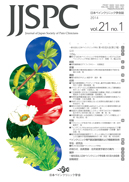Volume 21, Issue 4
Displaying 1-16 of 16 articles from this issue
- |<
- <
- 1
- >
- >|
-
2014 Volume 21 Issue 4 Pages 489-498
Published: 2014
Released on J-STAGE: November 07, 2014
Advance online publication: October 06, 2014Download PDF (2270K)
-
2014 Volume 21 Issue 4 Pages 499-505
Published: 2014
Released on J-STAGE: November 07, 2014
Advance online publication: September 30, 2014Download PDF (614K) -
2014 Volume 21 Issue 4 Pages 506-510
Published: 2014
Released on J-STAGE: November 07, 2014
Advance online publication: October 06, 2014Download PDF (365K)
-
2014 Volume 21 Issue 4 Pages 511-514
Published: 2014
Released on J-STAGE: November 07, 2014
Advance online publication: September 30, 2014Download PDF (265K) -
2014 Volume 21 Issue 4 Pages 515-518
Published: 2014
Released on J-STAGE: November 07, 2014
Advance online publication: September 30, 2014Download PDF (296K) -
2014 Volume 21 Issue 4 Pages 519-523
Published: 2014
Released on J-STAGE: November 07, 2014
Advance online publication: October 06, 2014Download PDF (1425K) -
2014 Volume 21 Issue 4 Pages 524-527
Published: 2014
Released on J-STAGE: November 07, 2014
Advance online publication: October 06, 2014Download PDF (592K) -
2014 Volume 21 Issue 4 Pages 528-531
Published: 2014
Released on J-STAGE: November 07, 2014
Advance online publication: October 06, 2014Download PDF (339K)
-
2014 Volume 21 Issue 4 Pages 532-533
Published: 2014
Released on J-STAGE: November 07, 2014
Advance online publication: September 30, 2014Download PDF (227K) -
2014 Volume 21 Issue 4 Pages 534-536
Published: 2014
Released on J-STAGE: November 07, 2014
Advance online publication: September 30, 2014Download PDF (248K) -
2014 Volume 21 Issue 4 Pages 537-538
Published: 2014
Released on J-STAGE: November 07, 2014
Advance online publication: September 30, 2014Download PDF (186K) -
2014 Volume 21 Issue 4 Pages 539-541
Published: 2014
Released on J-STAGE: November 07, 2014
Advance online publication: September 30, 2014Download PDF (413K) -
2014 Volume 21 Issue 4 Pages 542-544
Published: 2014
Released on J-STAGE: November 07, 2014
Advance online publication: October 06, 2014Download PDF (325K)
-
2014 Volume 21 Issue 4 Pages 545-546
Published: 2014
Released on J-STAGE: November 07, 2014
Download PDF (241K) -
2014 Volume 21 Issue 4 Pages 547-551
Published: 2014
Released on J-STAGE: November 07, 2014
Download PDF (395K) -
2014 Volume 21 Issue 4 Pages 552-559
Published: 2014
Released on J-STAGE: November 07, 2014
Download PDF (481K)
- |<
- <
- 1
- >
- >|
